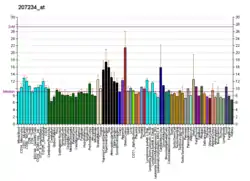RFX3
Transcription factor RFX3 is a protein that in humans is encoded by the RFX3 gene.[5][6]
This gene is a member of the regulatory factor X gene family, which encodes transcription factors that contain a highly-conserved winged helix DNA binding domain. The protein encoded by this gene is structurally related to regulatory factors X1, X2, X4, and X5. It is a transcriptional activator that can bind DNA as a monomer or as a heterodimer with other RFX family members. Two transcript variants encoding different isoforms have been described for this gene, and at least one of the variants utilizes alternative polyadenylation signals.[6]
References
- GRCh38: Ensembl release 89: ENSG00000080298 - Ensembl, May 2017
- GRCm38: Ensembl release 89: ENSMUSG00000040929 - Ensembl, May 2017
- "Human PubMed Reference:". National Center for Biotechnology Information, U.S. National Library of Medicine.
- "Mouse PubMed Reference:". National Center for Biotechnology Information, U.S. National Library of Medicine.
- Reith W, Ucla C, Barras E, Gaud A, Durand B, Herrero-Sanchez C, Kobr M, Mach B (Feb 1994). "RFX1, a transactivator of hepatitis B virus enhancer I, belongs to a novel family of homodimeric and heterodimeric DNA-binding proteins". Mol Cell Biol. 14 (2): 1230–44. doi:10.1128/mcb.14.2.1230. PMC 358479. PMID 8289803.
- "Entrez Gene: RFX3 regulatory factor X, 3 (influences HLA class II expression)".
Further reading
- Emery P, Durand B, Mach B, Reith W (1996). "RFX proteins, a novel family of DNA binding proteins conserved in the eukaryotic kingdom". Nucleic Acids Res. 24 (5): 803–7. doi:10.1093/nar/24.5.803. PMC 145730. PMID 8600444.
- Iwama A, Pan J, Zhang P, et al. (1999). "Dimeric RFX proteins contribute to the activity and lineage specificity of the interleukin-5 receptor alpha promoter through activation and repression domains". Mol. Cell. Biol. 19 (6): 3940–50. doi:10.1128/mcb.19.6.3940. PMC 104353. PMID 10330134.
- Morotomi-Yano K, Yano K, Saito H, et al. (2002). "Human regulatory factor X 4 (RFX4) is a testis-specific dimeric DNA-binding protein that cooperates with other human RFX members". J. Biol. Chem. 277 (1): 836–42. doi:10.1074/jbc.M108638200. PMID 11682486.
- Nakayama A, Murakami H, Maeyama N, et al. (2003). "Role for RFX transcription factors in non-neuronal cell-specific inactivation of the microtubule-associated protein MAP1A promoter". J. Biol. Chem. 278 (1): 233–40. doi:10.1074/jbc.M209574200. PMID 12411430.
- Strausberg RL, Feingold EA, Grouse LH, et al. (2003). "Generation and initial analysis of more than 15,000 full-length human and mouse cDNA sequences". Proc. Natl. Acad. Sci. U.S.A. 99 (26): 16899–903. Bibcode:2002PNAS...9916899M. doi:10.1073/pnas.242603899. PMC 139241. PMID 12477932.
- Maijgren S, Sur I, Nilsson M, Toftgård R (2004). "Involvement of RFX proteins in transcriptional activation from a Ras-responsive enhancer element". Arch. Dermatol. Res. 295 (11): 482–9. doi:10.1007/s00403-004-0456-5. PMID 15024578. S2CID 2408607.
- Humphray SJ, Oliver K, Hunt AR, et al. (2004). "DNA sequence and analysis of human chromosome 9". Nature. 429 (6990): 369–74. Bibcode:2004Natur.429..369H. doi:10.1038/nature02465. PMC 2734081. PMID 15164053.
- Gerhard DS, Wagner L, Feingold EA, et al. (2004). "The status, quality, and expansion of the NIH full-length cDNA project: the Mammalian Gene Collection (MGC)". Genome Res. 14 (10B): 2121–7. doi:10.1101/gr.2596504. PMC 528928. PMID 15489334.
- Rual JF, Venkatesan K, Hao T, et al. (2005). "Towards a proteome-scale map of the human protein-protein interaction network". Nature. 437 (7062): 1173–8. Bibcode:2005Natur.437.1173R. doi:10.1038/nature04209. PMID 16189514. S2CID 4427026.
This article incorporates text from the United States National Library of Medicine, which is in the public domain.




